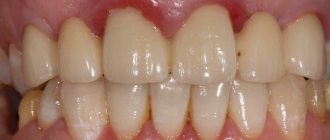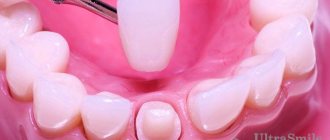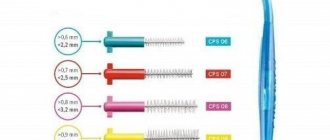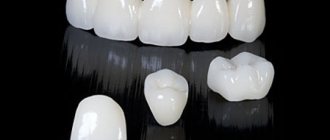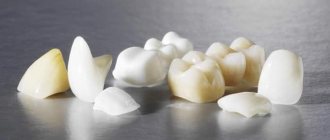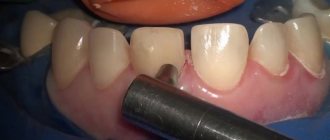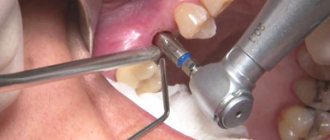Our teeth perform two important functions:
- We use our teeth to bite and chew food.
- Beautiful teeth make us more attractive
to chew food thoroughly is very important for human health.
If teeth are partially destroyed or, as a result of treatment, they have not been restored to their original strength, it is necessary to limit the consumption of solid foods, which means that the diet will be less varied.
The second function of teeth is purely aesthetic , but important for many public figures and everyone who cares about their appearance.
Depending on the degree of tooth destruction, its condition, position in the jaw and aesthetic requirements, doctors offer different restoration methods. You will learn more from the article Dental restoration. Filling, inlay or crown?
What types of prostheses are there, which ones are better to install?
Crowns are fixed to the visible part of the element using a special dental compound. Prosthetics with crowns allows you to simultaneously restore chewing function and the anatomy of the dentition.
Teeth crowns differ in material and, accordingly, in price. To decide which crowns are best placed in a particular clinical case, you should outline the pros and cons of each type of prosthesis
Plastic crowns
Such products are used as temporary crowns. They are lightweight, quick to manufacture and inexpensive. The structures are fixed to ground teeth or implants (while the permanent prosthesis is being prepared).
The mission of temporary crowns is to evenly distribute the chewing load on the dentition, while reducing the risk of developing bone atrophy in the jaw and further accelerating the process of getting used to the permanent prosthetic structure.
Metal-plastic crowns
The most inexpensive option for prosthetics. The crown is based on a metal alloy (cobalt, chromium, nickel). To give the prosthesis a natural appearance, the base is covered with a layer of plastic. In case of minor chips in the material, the product can be repaired directly in the patient’s mouth.
Metal-plastic structures are not strong enough - they can last a person up to 3 years. Over time, products lose color, slightly increase in size, and can cause allergies.
Metal ceramics
Metal-ceramic crowns are the true “golden mean” - the products are quite reliable and aesthetic. The surface of the prosthesis is ceramic, and the base is a metal alloy.
When making dentures from precious metals (gold, silver, palladium), you can count on a more natural appearance of the structure. In this case, the metal base will not give off a grayish tint through the coating, as is the case with conventional metals.
The relatively low price of metal-ceramic prosthetics with its acceptable functional and aesthetic indicators makes this method of tooth restoration the most popular. However, before making a choice in favor of metal ceramics, it is worth considering the risk of developing an allergy to metal, as well as the minimal likelihood of chipping the ceramic coating.
Metal crowns
This type of prosthesis is less popular these days. The product looks like a metal cap that is placed on a damaged tooth or titanium root. The strength of these crowns is enviable. A significant disadvantage of such products is their unaesthetic appearance: metal in the oral cavity is difficult to hide from prying eyes.
The denture is made in a dental laboratory. The basis is steel, titanium, as well as gold and platinum. In dentistry, there are two types of metal crowns:
- stamped. These are standard caps that are given an individual shape in the patient’s mouth. The products have thin walls, so they wear out quickly and are very rarely used in practice;
- cast. The designs are prepared on the basis of personal casts. This technique makes it possible to produce dentures that fit perfectly to hard tissue, eliminating the spread of bacteria in the space between the denture and dental tissue.
In the process of manufacturing metal crowns, spraying technology is often used. The material for these purposes is chosen at the request of the patient (gold, zirconium dioxide, plate).
Metal-free crowns
This type of crown has the highest aesthetics - it is very difficult to distinguish them from natural teeth. The following materials can be used in the production of prostheses:
- porcelain or pressed ceramics. The most attractive looking crowns. They are inferior to their analogues in strength, but are absolutely safe for the patient - they have a high biocompatibility index;
- zirconium dioxide. A durable material that is superior to alternative options in aesthetics - teeth with such crowns look like natural ones in the mouth. Other advantages of zirconium dioxide crowns include: safety, resistance to breakage, long service life;
- aluminium oxide. This material is slightly lighter than zirconia, making it most preferred when restoring anterior teeth. Products made from aluminum oxide are hypoallergenic and do not change their shade.
When it cannot be installed
Unfortunately, in medicine there is no universal treatment method that would suit everyone without exception. Before placing a crown on a tooth, discuss possible contraindications with your doctor:
- the presence of inflammatory processes in the acute stage (common stomatitis, periodontitis, pulpitis and other diseases, for example, periodontal disease and gingivitis);
- malocclusion.
Varieties
The difference in tissues from which dental crowns are created depends on the type of teeth:
- More attention is paid to the front teeth; it is important for patients to obtain an aesthetically pleasing result with a natural color, since they are the focus of attention when communicating;
- on chewing teeth, it is possible to use cheap and simple materials, especially when located far away; however, the structure must be durable to bear the chewing load.
Additional information: children of the nineties remember the golden bridges that adults flaunted, including on the visible row - a symbol of prosperity and wealth. Professional dentistry has long moved away from “jewelry” in the production of prosthetics, however, according to reviews on the Internet, this method of prosthetics is still found in settlements remote from the center.
Metal
Metal is suitable for crowns on chewing teeth because of its strength to withstand the daily stress of eating food. An older and less applicable method of tooth replacement.
Titanium construction is a hypoallergenic installation that causes a lower percentage of rejection.
The lack of visual aesthetics reduces the popularity of such systems, however, customers are attracted by the low cost and durability.
Metal ceramics
A metal-ceramic tooth crown is a frame made of precious metals (gold, platinum, palladium) and an outer ceramic “case” to give a natural look to the new denture.
Porcelain veneer is selected in accordance with the color of the dentition, so as not to differ from its neighbors and at the same time be highly durable and wearable for up to 15 years.
A popular type of restoration that provides a guaranteed result at a relatively low cost.
Advantages:
- durability;
- suitable for 99% of those who seek help;
- safety due to hypoallergenic raw materials.
Only ceramics
A ceramic crown is suitable for fixing to a tooth in the smile area - a place where a person does not make chewing movements, since ceramics are strong, but not strong enough for constant pressure.
The structure on the metal frame “shines through” the metal, thereby increasing the yellowness and reducing the beauty of the altered tooth. When installed without a metal structure, there will be nothing to “shine through”.
Metal-based plastic
This replacement of a lost tooth is suitable only for temporary use, for example, during the production of a permanent crown, as it has a number of obvious disadvantages:
- visibility of metal through the plastic “cap”;
- loss of original white color;
- fragility under constant exposure.
However, an affordable price and a shelf life of one to three years ensure a percentage of demand.
This type of material also includes a completely plastic crown, which is also intended for temporary wear. The advantages are similar: low costs, easier installation.
Zirconium
The most expensive orthopedic structures are made from zirconium dioxide or oxide, which has a bright white color and is as strong as devices with a metal base.
Due to its unique combination of properties, it is suitable for visible teeth as well as for the back row. In addition, they are not translucent and completely hypoallergenic.
Thus, to understand which dental crowns are better, it is necessary to understand the patient’s goals, financial capabilities and the location of the destroyed tooth.
Glass ceramics Emax
The desire for an aesthetically pleasing appearance of teeth pushes specialists to search for new materials for crowns. The Ivoclar Vivadent company from Liechtenstein offers an alternative to the usual raw materials - glass ceramics - an option for metal-free prosthetics (including veneers and bridges up to three units long).
The structure is 70% lithium disilicate, the advantages of which are:
- maximum resemblance to the enamel of real teeth;
- increased light transmittance (glass matrix);
- matching the color and texture of neighboring teeth, which makes it invisible in the dentition;
- wide selection of tones and shades.
In terms of its properties, glass ceramics outperforms its counterparts made of zirconium dioxide, therefore it is most applicable to the visible part of the jaw.
Despite the delicate level of design, it is highly durable due to its structure (pressed E-max Press or monolithic E-max Cad ceramics). Zirconium and metal ceramics tend to wear out over time, which inevitably leads to chips in more than 6% of patients.
E-max press is produced by pressing at high pressure and temperature.
Glass ceramics are suitable for:
- installation on single teeth, regardless of location (withstands chewing load);
- bridges up to three units even for the front teeth;
- installation of veneers and lumineers;
- high transparency enamel.
Contraindications:
- not suitable for distant chewing teeth (the last support is attached to a maximum of the fifth tooth);
- prohibited in the presence of bruxism;
- This is not possible if the tooth is of a dark color.
In addition, if more than 3 teeth are missing, installation of Emax is impossible, since the load on the chewing teeth will be distributed incorrectly (mainly on the preserved natural ones), which will lead to the destruction of the crowns, malocclusion and the location of the teeth.
Metal-free glass ceramics will cost the user much more than zirconium and metal-ceramic analogues, this is due to the unique design properties that make it possible to achieve one hundred percent coincidence and naturalness, therefore it is suitable for connoisseurs of real aesthetics.
What does the process involve?
After the patient chooses the material for the future denture, he will have to go through a preparatory stage, which includes:
- Consultation with an orthopedic dentist - during which they will conduct a detailed examination of the oral cavity for the presence of carious disease that prevents further work; at the first appointment, they will draw up a treatment plan and determine how much a crown per tooth costs;
Note! At the beginning, the doctor must include x-rays to determine the “scale of the disaster” and tissue destruction for an accurate diagnosis and determine the possibility of installing a prosthesis. Our clinic offers all types of x-ray examinations: targeted x-ray, panoramic dental x-ray, computed tomography.
- Sanitation - treatment of caries if present, getting rid of stomatitis and bruxism; in addition, dentists recommend undergoing hygienic treatment to avoid the possibility of introducing bacteria;
- If necessary, the tooth canals are cleaned;
- Tooth grinding - removal of a layer of the tooth (from 1.3 to 2 mm depending on the tissue of the structure), is carried out under local anesthesia, painlessly and takes about an hour; This procedure is also possible under a microscope, in this case fractions of a millimeter of tooth tissue are removed and accuracy increases;
- Taking impressions - for this purpose, an impression mass is used to make an impression of both jaws, or a scan of all teeth;
- Manufacturing of crowns - in a dental laboratory in accordance with the impressions obtained;
- The use of a temporary crown made of plastic is carried out especially on prominent teeth, so that the patient feels confident while the final crown is being made.
Next, after the crowns pass the control of the dental technician, the main stage occurs. During this period, the patient needs to listen to the sensations and in case of even minor inconvenience caused by the crown, inform the attending physician about this, at this stage corrections can be made.
Comparative characteristics of different types of dental crowns
The table below shows the characteristics of popular types of dental crowns. This information should be taken into account when choosing crowns for the front or chewing teeth.
| Comparison parameter | Metal ceramics + gold, silver, palladium | Metal ceramics + nickel, chrome | Pressed ceramics | Zirconium | Aluminium oxide | Metal-plastic |
| Possibilities of prosthetics | ||||||
| Single restoration | + | + | + | + | + | + |
| As part of a dental bridge | + | + | + | + | + | + |
| For metal intolerance | + | — | + | + | + | — |
| For sore gums | + | — | + | + | + | — |
| For sensitive enamel layer | — | — | + | + | + | + |
| Qualitative characteristics | ||||||
| Possibility of fixing without turning | — | — | + | — | — | — |
| Probability of chipping (scale - 5 points) | 2 | 3 | 3 | 1 | 1 | 5 |
| Maintaining aesthetics in % | 80 | 70 | 100 | 100 | 100 | 20 |
| Production | ||||||
| Manual technique | + | + | — | — | — | + |
| Computer modelling | — | — | + | + | + | — |
The essence of the application
With an anatomically correct bite, the upper front incisors protrude anteriorly in relation to the lower elements and overlap them by a third. Each chewing unit interacts with two antagonists. The mounds of elements overlap each other.
Several methods are available for correcting pathological occlusion, in particular the installation of permanent crowns.
An artificial crown is a prosthesis that is applied to the prepared surface of a damaged element protruding above the gum tissue.
The purpose of prosthetics is to restore the correct shape, eliminate crowding and speech or chewing defects, and restore the aesthetics of teeth.
Which crowns are best for back teeth?
The lateral teeth bear the basic load, so for their reconstruction it is worth using the strongest prosthetic products. Aesthetics in this case are less important. However, not any unaesthetic material (metal) will be compatible with soft tissues - this is also worth taking into account when choosing crowns for molars.
Metal prostheses are reliable and inexpensive, they very rarely break. The disadvantages of prosthetics with metal crowns are a low level of aesthetics and a high risk of developing allergies.
You can solve the problem of material incompatibility with fabrics by choosing products made of precious metals (gold-platinum alloy) for installation. They are safe and non-toxic. However, the price of a crown will be comparable to the cost of a ceramic product.
The most preferred option for prosthetics of lateral teeth remains metal-ceramics. This choice of most patients can be called justified, because a metal-ceramic crown is an excellent ratio of price and quality. Compared to a metal structure, such a prosthesis is inferior only in strength (there is a risk of chipping the ceramic coating). Blueness of the gums, which is formed as a result of contact between metal and soft tissues, is not embarrassing, since we are talking about prosthetics in the area of chewing teeth.
It is not recommended to place all-ceramic structures on teeth, since they are not very durable - there is a high risk of chipping and breaking. An alternative to classic ceramics can only be E-max glass ceramics - a durable analogue at a higher price.
Products made from zirconium dioxide are the strongest and most durable, which is why they are often recommended for use in dental restoration. However, in this case, it is preferable to use exclusively monolithic zirconium crowns (the veneer may break off).
Indications and restrictions
Installation of crowns to correct the bite is indicated in the following cases:
- surface defects that are not practical to eliminate with filling;
- reduced or enlarged teeth;
- the interdental space is greatly increased;
- teeth are crooked or rotated;
- the upper part of the teeth is significantly destroyed;
- discrepancy of teeth.
Not all bite defects can be corrected by installing a permanent crown. The limitation will be a violation of not only the shape, but also the root of the tooth, and the small thickness of the tooth. In this case, there is a risk of thermal burn of the pulp and a small supply of dentin, which may not be enough for grinding.
Which crowns are best placed in the smile area?
When fixing crowns on the front teeth, much attention is paid to the aesthetics of the result. The main task of the prosthesis is to be strong enough and not stand out against the background of natural teeth. When restoring the upper and lower dentition, identical design options are used.
Today, metal crowns are not placed on the front teeth. This statement is true both for products made of ordinary metals and precious ones.
Metal-ceramics is a good-priced, but aesthetically controversial, prosthetic option. The metal base of the structure is visible through the ceramics; over time, a bluish rim forms at the site of contact of the gums with the metal. To eliminate the second drawback, dentists offer to install metal-ceramic crowns with shoulder mass on the front teeth. However, this type of prosthetics is more expensive.
Prostheses made of medical porcelain or pressed ceramics are the best option for prosthetics of the frontal area. The crowns look good and are able to withstand the load placed on this area. The price of the products is quite affordable.
Constructions made of zirconium dioxide (aluminum oxide) should be installed if the color of the teeth in the smile area is significantly changed. In this case, a zirconium frame and porcelain lining will be the best option. The cost of such prosthetics is comparable to the price of ceramic crowns.
Can veneers correct crooked teeth?
Crowded teeth, too large gaps between them, and their crooked position are standard indications for orthodontic treatment using braces or aligners. However, in cases where such anomalies are minor, veneers and crowns can be used as a solution to the problem. So, is it possible to correct crooked teeth with veneers? The answer to this question depends on the degree of complexity of the case and the area in which correction is required.
In some cases, crooked teeth can be corrected with veneers. They will be a good solution in case of slight crowding of the front teeth and the presence of a gap. If your teeth require significant correction, then it is best to choose ceramic veneers. Firstly, it will be reliable, and secondly, it will be aesthetically pleasing. Composite veneers, or, in fact, artistic restoration with composite materials, are best used to correct small curvatures and gaps between teeth. As for the cost of such treatment, the latter option is cheaper than ceramic veneers, but it will also have its drawbacks. You can place a veneer on one crooked tooth or on several at once. However, veneering is used, as a rule, in the frontal area.
Before and after installing veneers on crooked teeth at the ILATAN clinic. Works by Zarivny S.S.
Service life of dental crowns made of different materials
The most short-lived are temporary crowns on teeth (plastic). In second place in terms of durability are products made of metal-plastic. The longest service life of structures is 5 years. However, patient reviews “speak” of premature darkening and deformation of the crowns.
Metal-ceramic dentures, which are successfully fixed to both the front and chewing teeth, usually last about 10 years. Artificial teeth made of ceramics remain the same in appearance and functionality for 10-15 years.
Metal crowns made of metal alloys last a long time and last at least 15 years.
Expensive materials - zirconium dioxide and aluminum oxide - last up to 20 years. The long service life justifies their high cost.
The service life of prosthetic structures is determined not only by the quality of their manufacture, but also by the care they are provided after installation.
Disadvantages of plastic crowns –
The main reason for the short service life of plastic crowns is their significantly lower strength (compared to any other types of crowns), as well as the high rate of abrasion of the chewing surface. As a result, with prolonged use there is a high risk of fractures and cracks in the frame of plastic crowns. Plastic crowns made of PMMA have higher strength (about 130 MPa, which is comparable to the strength of crowns made of feldspathic ceramics).
The patient can warn the doctor in advance that for some reason he plans to wear temporary crowns for longer than expected (for example, several months or more). In this case, the doctor will probably suggest that you make temporary crowns with reinforced fiberglass or with a frame made of metal mesh, or again, from PMMA. But you need to be prepared that the cost of each such crown will be 2000-3000 rubles more - compared to a regular plastic crown.
How long can you walk with temporary crowns? In general, walking for more than 1 month with temporary plastic crowns (made from ordinary acrylic plastic by direct or laboratory methods) is not recommended. Firstly, they have a rather negative effect on the gums around the crown, promoting the development of inflammation in it. Secondly, they have a fairly low manufacturing accuracy and may not fit tightly around the neck of the tooth, which can lead to saliva and bacteria getting under the crown and rotting of the tooth tissue.
The mechanical strength of a temporary plastic crown will depend on its thickness. For example, for metal-ceramics, the tooth is ground on all sides by an average of 1.5-2.0 mm, and in this case the plastic crown on the tooth is thick and strong enough to last for quite a long time (however, if you plan to wear such crowns for six months and more - in any case, their frame needs to be additionally reinforced). For a ceramic crown, the tooth is ground down only 1.0-1.5 mm, and therefore a temporary crown on a tooth of this thickness will last only a very short time.
Disadvantages of acrylic plastic crowns –
- low strength,
- rapid abrasion of the chewing surface as a result of friction against antagonist teeth,
- plastic is capable of absorbing odors, and therefore after a while begins to emit an unpleasant odor and taste,
- plastic is capable of absorbing dyes, and with prolonged use it acquires a dirty gray color,
- plastic has pores that are gradually colonized by bacteria and subsequently serve as a source of infection,
- chemical components of plastic can cause allergic reactions,
- with prolonged contact with the gums, plastic crowns contribute to the development of inflammation in it,
- temporary crowns, as a rule, have a fairly low accuracy of fit to the neck of the tooth, which, with prolonged use of crowns, can lead to the onset of rotting of the tooth tissue,
- plastic crowns are not suitable for permanent prosthetics also because the supporting teeth under them must be subjected to very strong grinding (in order to make the walls of the crown thicker and stronger).
Important: in some cases, the safety margin of plastic crowns can last quite a long time - from 1 to 2 years (for example, if they were made of PMMA, or the frame was additionally reinforced). But in any case, we still do not recommend using plastic crowns for more than 3 months, because... even the best of them cannot be a replacement for permanent crown options (for example, ceramic or metal-ceramic).
The highest quality plastic crowns, which also fit the necks of the ground teeth as accurately as possible, can only be manufactured using CAD/CAM technology, which involves milling on a computer-controlled machine. In addition, if we are talking about a temporary crown on an implant (especially in the anterior areas of the dentition), it is better to choose only milled plastic crowns with screw fixation.
How to properly care for dental crowns
Following simple recommendations for caring for dentures will help extend the “life” of dental crowns. Regardless of the material of manufacture, dentists advise patients to provide the structures with the following care:
- brush your teeth using a toothbrush and toothpaste twice a day (morning and evening). Clean not only teeth, but also cheeks and tongue from plaque;
- use a paste of medium (soft) abrasiveness. Large particles in pastes harm not only the enamel of natural teeth, but also the surface of dentures;
- Clean spaces between teeth using dental floss. As an alternative, you can use a irrigator or a special brush;
- when wearing a bridge, it is good to clean the intermediate crown;
- rinse your mouth with mouthwash or running water after each meal;
- limit the consumption of foods with dyes - coffee, black tea, chocolate, red wine, etc.;
- do not overload dentures - do not eat too hard foods, get rid of bad habits (do not open lids with your teeth, do not chew a pencil, etc.);
- Avoid sudden temperature changes that can cause chipping of the ceramic layer.
For preventive purposes, the patient is recommended to visit the dentist every six months; at the same interval, the patient is recommended to undergo professional cleaning of the oral cavity.
How to install a metal crown
The procedure is generally similar to installing other types of crowns.
The preparatory stage includes diagnostics of the oral cavity (patient survey, examination in the dental chair, x-ray). All problematic teeth are treated or removed. Only after this do we proceed directly to the installation procedure:
- The tooth is prepared for a crown, removing the pulp (in most cases) and grinding.
- An impression is taken to create a plaster model of the jaw.
- In a dental laboratory, a crown is made taking into account the selected metal.
- They try on and make adjustments in the patient’s oral cavity.
- The finished structure is fixed using cement compounds.
On a note! When installing metal crowns, minimal grinding of the tooth is required.
The process takes from 3 days to 2 weeks (depending on the amount of work). During this period, the patient can have a simple plastic crown installed to temporarily protect the tooth.
Reviews from doctors and patients
Dentists consider dentures with crowns to be an excellent way to restore significantly damaged elements. Doctors note a significant advantage of this solution - it is an opportunity to prevent the destruction of a “dead” tooth or even preserve a “living” unit (if it is partially destroyed). This method cannot be called universal only because it has a number of contraindications, one of which is root damage.
Patients, for the most part, speak positively about prostheses of this type. They note the rapid restoration of functionality and aesthetics of the series, ease of use and durability of the prostheses.
An alternative to crowns for chewing teeth
It should be remembered that even in the presence of significant damage, a tooth can be restored using a conventional light-composite filling and pin. If it is necessary to eliminate a single defect, implant fixation is recommended.
Which is preferable: a filling, a pin or a crown?
As mentioned earlier, with significant destruction of the coronal part of the tooth (more than 50%), it is possible to recreate it using a light-composite filling mass. In this case, a pin made of fiberglass or metal material is used, which allows for more reliable fixation of such a filling.
If the tooth crown is destroyed by more than 50%, experts recommend resorting to the use of a prosthesis. This primarily applies to units from which the pulp has been removed, as these are considered the most fragile.
Also, in case of significant destruction of the coronal part, dentists use a special stump insert, which ensures a more durable installation of the prosthesis.
What to choose: a crown or a dental implant?
When considering the replacement of missing units with crowns, implant fixation is the preferred option for eliminating a single defect. When using a dental structure, the need to prepare teeth that act as supporting elements is eliminated. In addition, implants have a longer period of use, in contrast to single prosthetic structures and bridges.
Pros and cons of straightening teeth with veneers
This alignment method has numerous advantages, but there are also disadvantages. Therefore, before you contact your dentist with a request to install veneers on crooked teeth, you need to carefully weigh and consider everything.
Table. Pros and cons of installing veneers for crooked teeth
| pros | Minuses |
| There is no need to install braces or wear long-lasting mouth guards. Everything happens quickly. | Braces straighten teeth permanently. Veneers last about ten years on average before they need to be replaced. |
| The effect is achieved in one action; there is no need for subsequent bleaching. | The enamel layer is cut off under the overlays. It cannot be restored, so veneers will have to be done again every ten years. |
| High aesthetic performance. | There are many contraindications for installing veneers. |
| Veneers can straighten teeth even in adulthood and old age, when the use of braces is ineffective. | They correct only a small degree of curvature and mask shallow gaps between teeth. |
Veneers require special care and periodic replacement
When choosing veneers as an alternative method of teeth straightening, you need to understand that they do not straighten anything. The dentition, as crooked as it was, will remain so. But visually everything will look very aesthetically pleasing. And you will get the result quickly.
Veneers allow you to quickly correct imperfections in the dentition or enamel defects
In any case, in order to choose one or another method of correcting or masking curvatures, you must visit a dental clinic and undergo a consultation with an orthopedist or orthodontist. The first one will install overlays if there are indications for this. The second must make sure that you have no contraindications to installing veneers.
- Dental veneers - what are they?
Veneers are installed only for those who have no contraindications to the procedure.
Not every patient who complains of crooked teeth is indicated for veneering. Aesthetic correction is just an elegant and quick way to disguise imperfections. Moreover, it is not cheap. And if you consider that every decade, after a maximum of 15 years, with very good luck and super-careful attitude towards veneers, they will still have to be replaced, the question of whether it is worth straightening your teeth in this way remains quite controversial.
Aesthetic correction
It is impossible to decide once and for all what is better, veneers or braces. But in each individual case, a professional dentist will find the most appropriate method that will be ideal for you and will give you a long-awaited beautiful smile.
What types of veneers are there?
During your consultation, your dentist will determine exactly whether it is possible to install veneers (Lumineers) in your case. And if this method is suitable to correct the existing defect, you will need to decide which veneers to install.
Lumineers
Aesthetic overlays today are made in two types. The strongest and most durable are ceramic ones. Providing easier restoration – made of composite materials.
Features of ceramic veneers
For their manufacture, which takes place in a prosthetic laboratory using ready-made casts, a special type of ceramic is used. It contains pressed porcelain powder and silicon dioxide. The materials are processed in accordance with the most modern technologies, so they last a long time and are highly durable.
Ceramic veneers
By the way. Ceramic veneers can be easily matched in color to the natural shade of the teeth if onlays are installed only on a few front incisors that extend out of the row. If installed on the entire row, they can be given the shade of the desired degree of whiteness.
They will not darken or become cloudy over time. Deformation of the plates themselves is unlikely. With significant force pressure and load, veneers can break off from the tooth, so they are not placed on chewing molars, and after installation it is not recommended to chew nuts, open bottles with your teeth, and do other similar things.
Ceramic veneers for teeth
Features of composite veneers
Firstly, they are cheaper than ceramic ones. Secondly, they are installed much faster. Modern composite materials are used for manufacturing. Essentially, it is a super-strong filling that is done right there in the dentist's office. To install composite veneers, you do not need to take impressions and wait two weeks for the onlays to arrive from the laboratory. But they cannot fully restore the aesthetic appearance, since composite materials are difficult to match the original teeth. In most cases, fillings, even super-strong ones, look like fillings. Low transparency, different shade.
Use of composite veneers
By the way. Composite veneers can be used to mask only minor and incomplete curvature of the dentition. In addition, they darken over time and do not have the same strength that is inherent in ceramic linings.
Composite veneers
